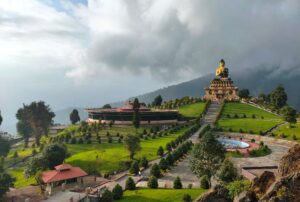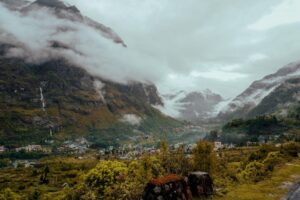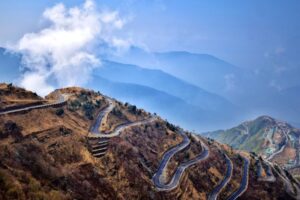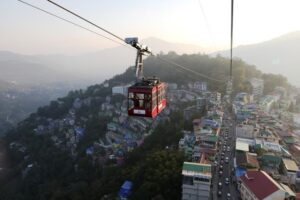Nestled in the lap of the Himalayas, Sikkim beckons travelers with its awe-inspiring landscapes and cultural richness. Beyond the popular trekking trails and scenic views lies a spiritual tapestry woven into the very fabric of the region.
Pilgrimage destinations in Sikkim are not only places of worship but also of scenic beauty and cultural diversity. Sikkim is home to various religions, such as Buddhism, Hinduism, Christianity, Islam, and Sikhism, and each of them has its sacred sites and traditions.
Here are the 10 most popular pilgrimage destinations in Sikkim that you must explore:
Rinchenpong Monastery
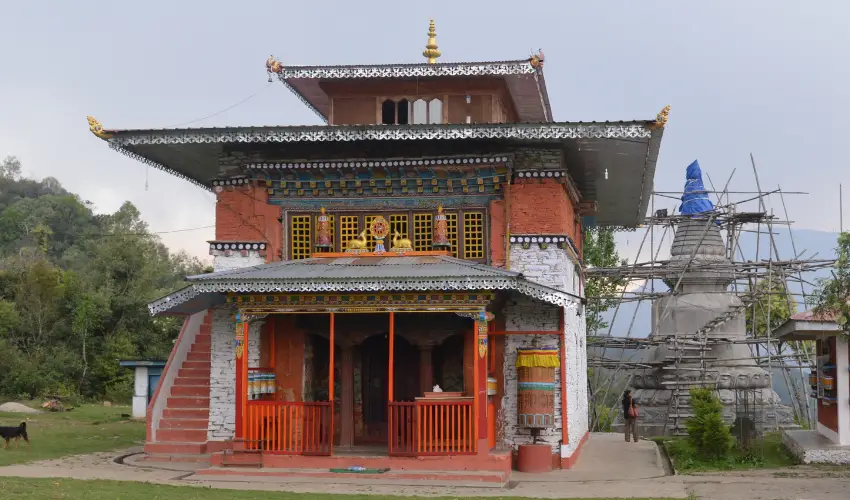
Nestled at 5,500ft, Rinchenpong Monastery is one of the oldest and most revered gompas in Sikkim. It is located on a scenic mountain path that affords a spectacular view of the Kanchenjunga, the third-highest peak in the world. What makes this gompa even more special is the presence of a rare statue of Ati Buddha in the Yab-Yum posture, which symbolizes the union of wisdom and compassion. This gompa has been an integral part of Rinchenpong village for nearly 300 years and is a vital stop for anyone who wants to explore the rich heritage of Sikkim.
Rinchenpong village is a charming and peaceful place that complements its beauty. It boasts a stunning view of the Kanchenjunga and other snow-capped mountains of the Himalayan range. The trail to the monastery is adorned with colorful prayer flags that wave in the wind, creating a serene and spiritual atmosphere. One can witness the harmony of ancient architecture and natural beauty in Sikkim as one walks up to the gompa.
Lachen Monastery

Lachen Monastery is a serene and beautiful place that attracts many visitors to Lachen. It was founded in 1858 A.D. by the Nyingma Sect of Tibetan Buddhism, who converted a small hut built by Lama Karchen Dorje Drak into a gompa with the help of eight monks. Lachen Monastery, also known as Ngodub Choling or the Launching Gompa, is situated at a scenic spot that offers a stunning view of the village and the mountains.
It also houses a statue of Guru Padmasambhava, the founder of Tibetan Buddhism. The monastery is adorned with colorful prayer flags and prayer wheels that create a spiritual and peaceful atmosphere. Lachen Monastery is a blissful and amazing place to visit for anyone who wants to experience the sacred and ancient culture of Sikkim.
Pemayangtse Monastery Pelling

Nestled in the upper reaches of western Sikkim, Pemayangtse Monastery, meaning ‘Perfect Sublime Lotus,’ beckons travelers with its fame and beauty. Just 2 kilometers from Pelling, a brief walk leads to this tranquil haven that captivates visitors throughout the year. The prime season to visit is the clear-skyed spring and summer, offering stunning views of the Himalayas and the serene surroundings.
Surrounded by woods, Pemayangtse Monastery provides an ideal escape for solace-seekers. As the second-oldest gompa in Sikkim, this 300-year-old monument showcases rich Buddhist architecture and unwavering faith. With three stories adorned with statues of saints and Rinpoches, including Padmasambhava, and housing ancient idols and scriptures, the monastery offers a glimpse into Sikkim’s cultural heritage. The main prayer hall, adorned with traditional Tibetan-style paintings, resonates with a sacred ambiance. From Pemayangtse Monastery, one can also catch sight of the ruins of Rabdantse, adding historical depth to this picturesque retreat.
Rumtek Dharma Chakra Center

Rumtek Dharma Chakra Center, near Gangtok, is a significant monastery with deep roots in Tibetan Buddhism. Established in 1966 by the 16th Karmapa, head of the Karma Kagyu school, as his exile seat, it’s alternately known as Rumtek Monastery or the Dharma Chakra Centre. Built on the grounds of an 18th-century gompa, founded by the 12th Karmapa, it now ranks among Sikkim’s largest monasteries. Home to a golden stupa housing relics of the 16th Karmapa, the complex also hosts a college, library, and museum showcasing Buddhist art and scriptures.
While the monastery serves as a hub for Kagyu sect learning, it’s also embroiled in a dispute over the recognition of the 17th Karmapa. The hillside location provides stunning Himalayan views, complemented by prayer flags and wheels, creating an atmosphere of serenity. Amidst controversy, Rumtek Dharma Chakra Center remains a must-visit, offering a profound immersion into Sikkim’s cultural and spiritual heritage.
Siddheswara Dham

Situated on the picturesque Solophok Hill in South Sikkim, Siddheswara Dham serves as a unique Pilgrimage-cum-Cultural Centre, dedicated to promoting Religious Tourism and providing a spiritual haven for visitors. Dominating the landscape is the towering 26½-meter-high statue of Lord Shiva, seated majestically, its visibility from afar marking the entrance to the main temple. Within the temple complex, replicas of twelve sacred Jyotirlingas and the four holy Dhams of Hinduism add to the spiritual allure. Encompassing an area of approximately 7 acres, Siddheswara Dham is embraced by the serene nature of Sikkim.
A haven for Lord Shiva devotees and those intrigued by Hinduism, Siddheswara Dham in South Sikkim beckons exploration. Beyond its spiritual offerings, the region boasts additional attractions, including the nearby Tendong Hill and Maenam Hill, inviting trekkers with panoramic views. Nature enthusiasts can further indulge in the biodiversity of Maenam Wildlife Sanctuary and Tendong State Biodiversity Park, making South Sikkim a multifaceted destination for adventure and natural wonders.
Pal Zurmang Kagyud Monastery
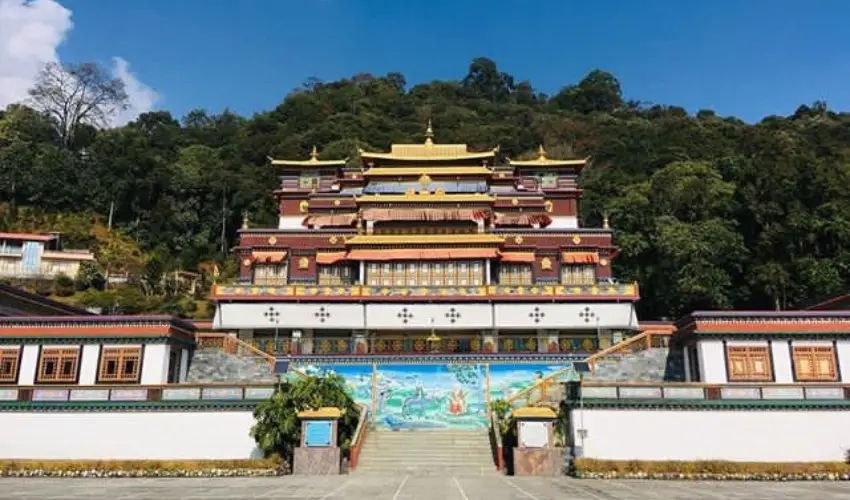
Established in 1999, Pal Zurmang Kagyud Monastery, also known as Lingdung Monastery, stands as a testament to Tibetan Monastic architecture. Located just a 45-minute drive, approximately 20 kilometers from Gangtok, along the Rumtek-Ranka-Gangtok road, this monastery is a hidden gem against the steep green hillside. Exhibiting the intricate design characteristic of Tibetan monastic structures, Pal Zurmang Kagyud Monastery is a serene retreat with multiple sacred rooms spread across several levels.
The spiritual legacy of the monastery is embodied in the present Gharwang Rinpoche, recognized as the 12th successive incarnation of the revered emanation of Zurmang Gharwang. This spiritual enclave not only offers a glimpse into Tibetan Buddhist architecture but also serves as a center for the continuation of a profound lineage, welcoming visitors to experience the tranquility and cultural richness embedded in its sacred spaces.
Ganesh Tok
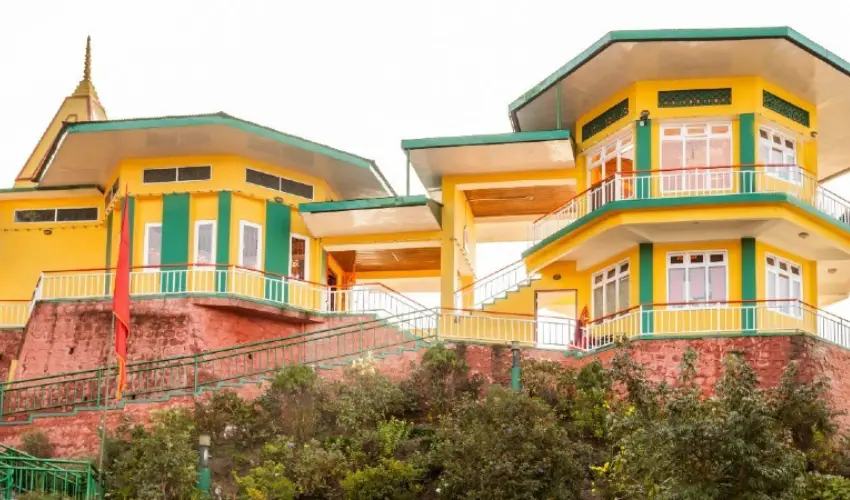
Ganesh Tok is a charming small temple atop a hill in Gangtok and a viewpoint offering breathtaking vistas. The morning reveals the true glory of the Kanchenjunga hill, visible in all its splendor from this elevated spot. Despite its size, accommodating only one person at a time, the temple dedicated to Lord Ganesh exudes spiritual charm.
Brightly colored flags adorning the stairs make Ganesh Tok easily recognizable. Practical amenities, such as a shoe-keeping area and handwashing facilities, enhance the visitor experience. The main attraction, however, is the lounge and balcony in front of the temple, providing an ideal vantage point for absorbing the scenic beauty. Adjacent to Ganesh Tok, Hanuman Tok, devoted to Lord Hanuman, sits at 7200 feet, offering an incredible panorama of the Kanchenjunga range. With religious significance and a peaceful ambiance, it is believed to fulfill devotees’ wishes.
Hanuman Tok

Hanuman Tok is a Hindu temple complex dedicated to Lord Hanuman located on the elevated terrains of Gangtok, meticulously maintained by the Indian army since its establishment in 1952. According to local legends, this sacred spot is believed to be where Hanuman rested during his journey to Dunagiri mountain, carrying the life-saving herb Sanjeevani to aid Lord Rama’s brother Lakshmana.
Devotees flock to this temple, drawn by the spiritual aura and the connection to the heroic tales of Hanuman. Positioned advantageously, Hanuman Tok offers a magnificent panorama of the mountains, especially breathtaking on clear and sunny mornings. Beyond its religious significance, the temple beckons visitors to experience both divine tranquility and the awe-inspiring beauty of the Himalayan landscape.
Sa Ngor Chotshog Center

Founded in 1961, just a half-hour drive, approximately 5 kilometers from central Gangtok, the Sa Ngor Chotshog Center stands as the sole monastery of the Sakya order of Tibetan Buddhism in Sikkim. Positioned on a picturesque hilltop, it was established by His Eminence Luding Khan Rinpoche, the head of Ngorpa, a sub-sect of the Sakya order, with the blessings of HH Sakya Trizing and HH Dalai Lama.
This sacred sanctuary received initial blessings from H.H. Sakya Trizin Rinpoche, the supreme head of the Sakyapa Sect, and later, the revered His Holiness the Dalai Lama. The lamas within the monastery observe the Summer Retreat known as “Yarney.” Above the monastery, within a lush green forest, lies a retreat center maintained by this monastery. Here, dedicated lamas engage in a three-year, three-month meditation called ‘Losum Dasum,’ contributing to the spiritual essence that permeates this serene landscape.
Baba Harbhajan Singh Memorial Temple
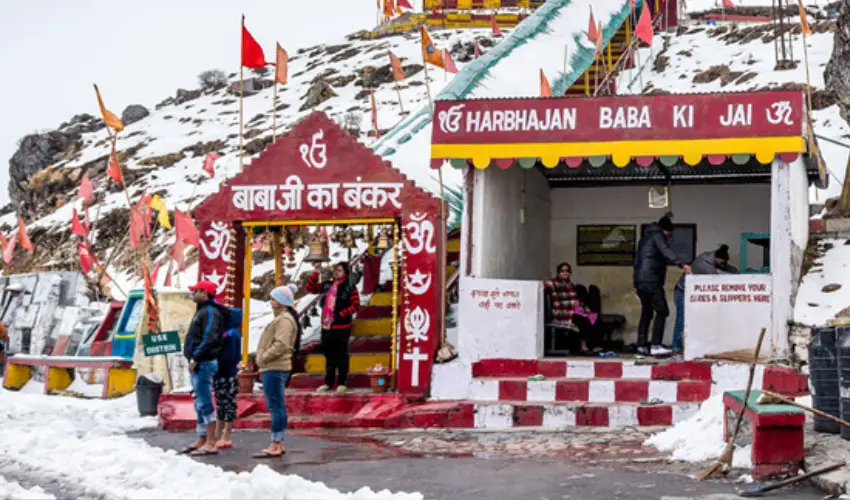
Baba Harbhajan Singh Memorial Temple was built as a tribute to Harbhajan Singh, a brave sepoy in the 23rd Punjab Regiment who lost his life on duty near the Nathula Pass. According to legend, Harbhajan Singh appeared in a dream a few days after going missing while patrolling the border, revealing the location of his body and expressing a wish for a samadhi in his memory. In adherence to his request, a samadhi was erected near Chhokya Chho at an elevation of about 4,000 meters, known as the Old Baba Mandir, though less frequented by tourists.
To reach the bunker and the site of the samadhi, visitors ascend 50 stairs – the very place where Baba served during his army tenure. For the convenience of tourists, the samadhi has been reconstructed at the junction of Kupup Gnathang road and the trail leading to Menmecho Lake, gaining popularity as the New Baba Mandir among visitors.
No permit is required by Indians. Foreigners only need a Restricted Area Permit to tour & trek South Sikkim. More details on how to obtain a Permit have been discussed in our previous article.
(To know more about Sikkim State Tourism check the link here.)


